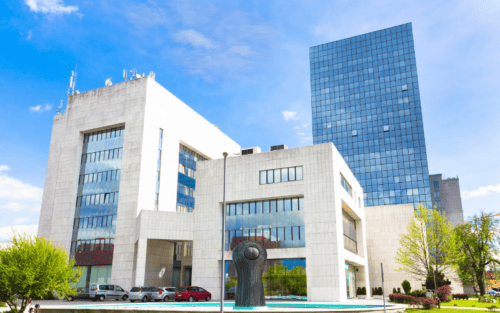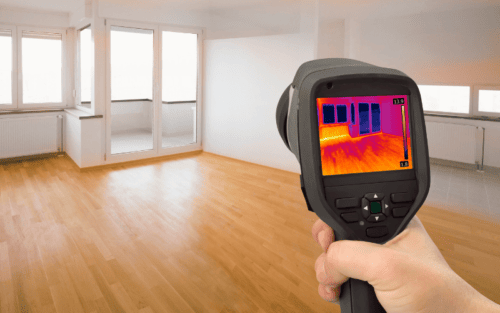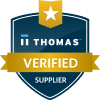
A building envelope serves as the physical barrier between the interior and exterior environments of a structure. It includes the foundation, walls, roof, windows, and doors that work together to protect against weather elements while maintaining indoor comfort. An effective building envelope reduces energy costs, prevents moisture damage, and extends the lifespan of your structure.
Why Your Building Envelope Matters
The quality of your building envelope directly impacts your energy consumption, indoor air quality, and structural integrity. According to ThermaCote’s research, buildings with compromised envelopes can waste up to 30% more energy than those with properly maintained systems.
Poor envelope performance leads to inconsistent indoor temperatures, higher utility bills and increased wear on your HVAC systems. You might not realize that envelope issues compound over time, with small problems eventually leading to significant structural damage and costly repairs.
Top 7 Tips to Improve Your Building Envelope
1. Conduct a Professional Envelope Assessment
Begin with a comprehensive evaluation of your current building envelope. Professional assessors can identify air leaks, thermal bridges (areas where heat transfers more rapidly through your building’s exterior), and moisture intrusion points that may not be visible to your untrained eye. This assessment establishes a baseline for improvement and helps prioritize your upgrades.

The evaluation typically includes thermal imaging scans, blower door tests to measure air tightness, and moisture mapping. These diagnostic tools provide quantifiable data about performance gaps in your envelope system. Many assessment professionals can also provide cost-benefit analyses for recommended improvements.
2. Seal Air Leaks and Gaps
Air leakage accounts for significant energy loss in most buildings. Common leak points in your structure include:
- Window and door frames
- Utility penetrations
- Joints between different building materials
- Attic hatches and basement rim joists
Use appropriate sealants for each application—caulk for stationary joints and weatherstripping for movable components. For larger gaps, expanding foam works well, while specialized tapes can seal ductwork and HVAC connections.
The EPA estimates that properly sealing air leaks can reduce your heating and cooling costs by up to 20%. This makes air sealing one of the most cost-effective envelope improvements available for your building.
3. Upgrade Insulation Systems
Proper insulation is fundamental to a high-performing building envelope. Consider these factors when upgrading your insulation:
- Select insulation with appropriate R-values (thermal resistance measurements) for your climate zone
- Pay special attention to your attic, which can account for up to 25% of heat loss
- Address thermal bridges where structural elements create pathways for heat transfer
- Ensure consistent coverage without gaps or compressed areas
Modern insulation options include traditional fiberglass, mineral wool, spray foam, rigid foam boards and eco-friendly alternatives like cellulose. Each type has specific applications where it performs best for different parts of your building. For example, spray foam excels at sealing complex junctions in your structure, while rigid foam provides excellent thermal resistance in limited spaces.
The payback period for your insulation upgrades varies by climate and energy costs but typically ranges from 2-5 years for most commercial and residential applications.
4. Apply Weather Barrier Coatings
Weather barrier coatings like ThermaCote provide an additional layer of protection while improving your building’s energy efficiency. These specialized coatings:
- Create a seamless protective barrier around your structure
- Reflect solar radiation to reduce heat gain
- Preserve your underlying insulation from moisture damage
- Extend the life of your building materials
Ceramic-based weather barriers offer advantages over traditional coatings because they form a continuous membrane that bridges minor cracks and seams in your building’s exterior. They can be applied to nearly any substrate, including concrete, metal, wood and existing roofing materials.
For your aging building, these coatings present a cost-effective alternative to complete envelope replacement, often extending service life by 10-15 years while simultaneously improving thermal performance.
Looking for a simple solution to multiple envelope challenges? Contact ThermaCote today to learn how our weather barrier solutions can improve your structure’s efficiency and longevity.
5. Modernize Windows and Doors
Windows and doors can be weak points in your building envelope. Consider these upgrade options for your structure:
- Double or triple-pane windows with low-E coatings
- Properly installed flashing around openings
- High-performance door systems with effective weatherstripping
- Storm windows or thermal curtains for existing windows
Modern window technologies incorporate gas fills, thermal breaks and specialized glazings that dramatically outperform older units. If you own a historic building where replacement isn’t practical, window films and interior storm panels offer substantial improvements without altering exterior appearance.
Your door upgrades should focus on tight seals, proper thresholds and, where appropriate, vestibule arrangements that create air locks at frequently used entrances. These improvements reduce air infiltration during operation while maintaining accessibility.
6. Improve Roof Performance
Your roof faces the harshest environmental conditions and plays a major role in envelope performance. To improve your roof’s contribution to the building envelope:
- Inspect for and repair damaged areas promptly
- Consider reflective roofing materials in hot climates
- Ensure proper ventilation to prevent moisture buildup
- Apply roof coatings to extend lifespan and improve thermal performance
The roof-wall junction represents a particularly vulnerable area in many buildings. Proper flashing, air barriers and insulation continuity at this junction prevent thermal bypasses that compromise your overall envelope performance.
For flat or low-slope roofs, white or reflective coatings can reduce your peak cooling loads by 15-30% in warm climates. These coatings also protect roof membranes from UV degradation, potentially doubling their service life.
7. Implement Moisture Management Strategies
Moisture intrusion damages your building materials and reduces insulation effectiveness. Protect your investment with these approaches:
- Install proper vapor barriers appropriate for your climate
- Ensure effective drainage away from your foundation
- Maintain gutters and downspouts
- Use breathable materials where needed to allow drying
Effective moisture management requires understanding how water vapor moves through your building assemblies in your specific climate. In cold climates, vapor barriers typically belong on the interior side of insulation, while humid climates may benefit from more permeable assemblies that allow drying to both interior and exterior.
Site grading plays a critical role as well, directing water away from your foundation and preventing capillary action that can draw moisture into building materials. French drains, proper downspout extensions and foundation waterproofing form a comprehensive approach to keeping your building dry from the ground up.
Implementing Your Building Envelope Improvements
Once you’ve identified the improvements your building needs, create a phased implementation plan based on priority and budget. Start with improvements that offer the highest return on investment or address immediate concerns like active leaks or damaged areas.
During the improvement process, coordinate with qualified contractors who understand building envelope systems. Proper installation is crucial—even the best materials will underperform if incorrectly applied. Keep detailed records of all improvements for future reference and warranty purposes.
Measuring Success: The Impact of Improvements
After implementing your building envelope improvements, it’s important to track results to justify your investment and identify any areas needing further attention. Monitor your energy usage to quantify savings and compare performance before and after improvements.
Many building owners report 15-25% reductions in energy costs following comprehensive envelope upgrades. Additional benefits you’ll likely notice include more consistent indoor temperatures, reduced HVAC workload, and fewer maintenance issues.
Energy monitoring systems can track performance over time, helping you identify when maintenance might be needed or verifying the effectiveness of improvements. You might also experience improved occupant comfort and productivity following envelope upgrades—benefits that may exceed direct energy savings in value.
How ThermaCote Weather Barrier Coating Improves Building Envelopes
ThermaCote weather barrier coating offers a simple yet effective solution for many of your building envelope challenges. This ceramic-based coating:
- Creates a tight building envelope that prevents air leakage
- Protects your insulation from degradation and moisture damage
- Extends the lifespan of your building materials through corrosion and UV protection
- Provides energy savings through thermal resistance and solar reflectance
- Offers an environmentally friendly solution with ultra-low VOCs
Ready to transform your building envelope? Contact ThermaCote today to learn how our weather barrier solutions can improve your structure’s efficiency and longevity.
Frequently Asked Questions
What is the difference between a tight and loose building envelope?
A tight building envelope has few air gaps or leaks, keeping your conditioned air inside and unconditioned air outside. This results in better energy efficiency and moisture control. A loose envelope has more unintentional openings, leading to drafts, energy waste, and potential moisture problems in your building.
How often should a building envelope be inspected?
Your building envelope should be inspected annually and after severe weather events. Regular inspections help identify small issues before they become costly problems. Professional assessments every 3-5 years provide more thorough evaluations of your structure.
Can improving my building envelope reduce my utility bills?
Yes. A well-functioning building envelope can reduce your heating and cooling costs by 15-25%. The U.S. Department of Energy estimates that sealing air leaks and adding insulation in attics, floors, and crawl spaces can save an average of 15% on heating and cooling costs.
What causes building envelope failure?
Common causes include poor initial design, improper material selection, low-quality workmanship, weather damage, and normal aging of materials. Regular maintenance and timely repairs can prevent most failures in your building envelope.
Are weather barrier coatings worth the investment?
Weather barrier coatings like ThermaCote provide excellent return on investment through energy savings, extended material lifespan, and reduced maintenance costs. Most building owners see complete payback within 3-7 years, with continued savings thereafter.

